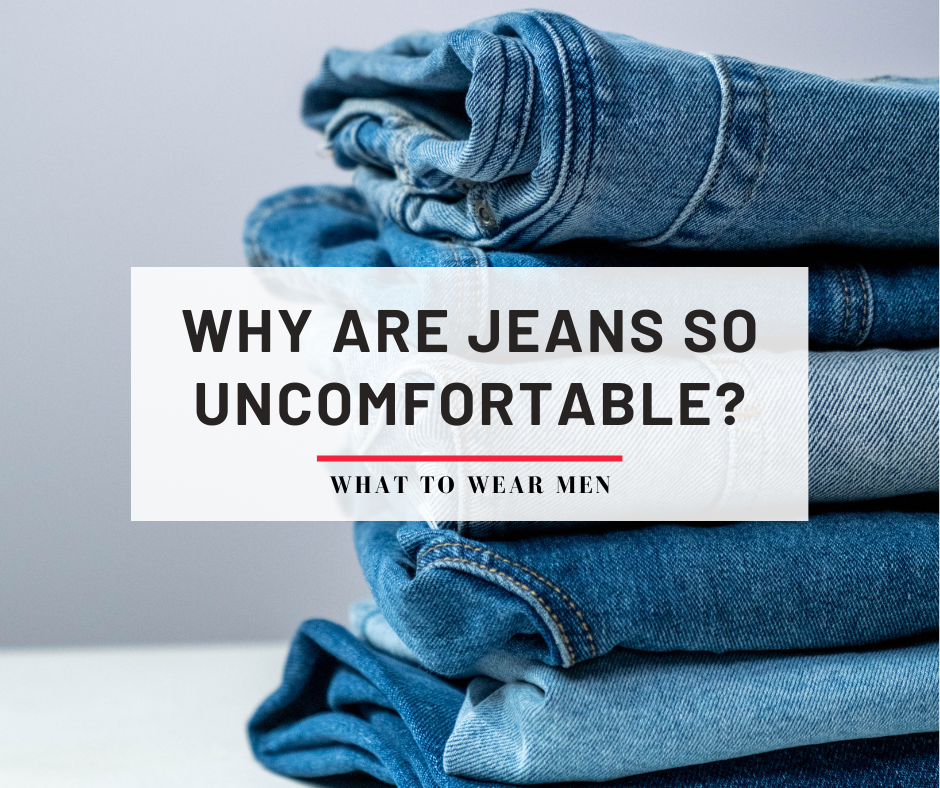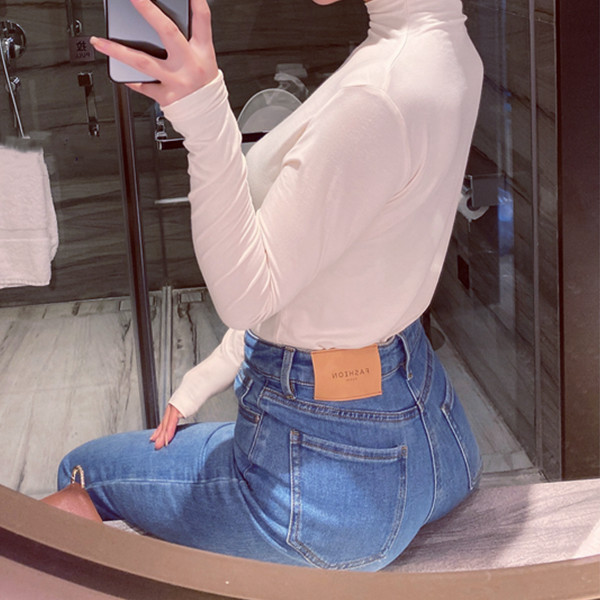Let’s be honest, we’ve all been there. Struggling to squeeze into a pair of jeans that feel more like a medieval torture device than fashionable attire. You know the feeling: the waistband digs in, the legs feel like they’re encased in concrete, and by the end of the day, you’re practically sprinting to your bedroom to peel them off. It’s a universal experience that begs the question: Are jeans inherently uncomfortable? Well, I’m here to tell you that while the struggle is real, it doesn’t have to be your reality.
Why Jeans Can Feel Uncomfortable
So, why are jeans uncomfortable for so many? It’s a complex issue with several contributing factors. It’s not just a matter of personal preference; there are tangible reasons why your favorite pair might be causing you grief. Let’s break down the key culprits:
The Fabric Factor: How Material Impacts Jean Comfort
The fabric of your jeans plays a crucial role in how comfortable they feel. Traditional denim is made from 100% cotton, which can be quite rigid, especially when it’s raw or unwashed. This lack of stretch can make movement feel restricted, contributing to that uncomfortable feeling. However, the denim world has evolved, and now we have a plethora of blends to choose from. Elastane (also known as spandex) is a game-changer, adding stretch and flexibility to denim. A small percentage of elastane can make a world of difference in terms of comfort and mobility. Polyester is another common addition, often used to enhance durability and reduce wrinkling. However, it can also impact breathability, so finding the right balance is key.
The “rigid denim” vs. “stretch denim” debate is a hot topic among denim aficionados. Rigid denim, favored by purists, offers a structured look and molds to your body over time, creating a personalized fit. However, it requires a breaking-in period and can be initially uncomfortable. Stretch denim, on the other hand, offers immediate comfort and flexibility, making it a popular choice for everyday wear. Ultimately, the best fabric for you depends on your personal preferences and priorities.
And let’s not forget about sustainable denim! Options like organic cotton and recycled materials are gaining traction, not only for their eco-friendliness but also for their potential comfort benefits. Organic cotton is often softer and gentler on the skin, while recycled denim can have a unique texture and feel.
The Fit Fiasco: Is Your Jean Fit the Culprit?
Perhaps the most significant factor contributing to jean discomfort is an ill-fitting pair. Jeans that are too tight in the waistband, hips, or legs can restrict circulation and cause discomfort. Conversely, jeans that are too loose can feel bulky and cumbersome. Finding the right fit is crucial for comfort. Different jean styles cater to different body types and preferences. Skinny jeans, while fashionable, can be notoriously uncomfortable if they’re too tight. Straight-leg jeans offer a more relaxed fit through the leg, while bootcut jeans provide extra room in the calf. Boyfriend jeans, with their relaxed and slouchy fit, are often praised for their comfort. Understanding your body shape and the characteristics of different jean styles is essential for finding a comfortable fit. And don’t forget the importance of accurate measurements! Knowing your waist, hip, and inseam measurements will help you choose the right size and avoid the discomfort of ill-fitting jeans. Be aware of vanity sizing, too – the size on the label might not always match your actual measurements.

Construction Concerns: How Design Affects Comfort
Beyond fabric and fit, the construction and design of your jeans can also impact comfort. Well-constructed seams, particularly in high-stress areas like the crotch and inner thighs, can prevent chafing and irritation. The placement and design of pockets can also affect comfort. Pockets that are too small or positioned awkwardly can feel restrictive. The rise of your jeans (the distance between the waistband and the crotch) is another important consideration. High-rise jeans can provide support and coverage, while low-rise jeans can feel more comfortable for some. Features like elastic waistbands or contoured waistbands can also enhance comfort. And let’s not forget about embellishments. While they can add style, excessive hardware or bulky embellishments can rub against your skin and cause discomfort.
Washing Woes: Can Jean Care Impact Comfort?
Believe it or not, how you wash and care for your jeans can affect their comfort. Improper washing can cause the fabric to shrink, stretch, or lose its shape, leading to discomfort. Over-washing can also strip the denim of its natural oils, making it feel stiff and scratchy. It’s essential to follow the care instructions on the label and avoid harsh detergents or bleach. Turning your jeans inside out before washing can help prevent fading and protect the fabric. Air drying is generally recommended, as machine drying can cause shrinkage. While some people swear by the “freezer method” for cleaning jeans, it’s not a substitute for proper washing.
Personal Preferences: Comfort is Subjective
Finally, it’s important to remember that comfort is subjective. What feels comfortable to one person might not feel the same to another. Personal preferences, body types, and lifestyle factors all play a role in determining what constitutes comfortable jeans. Don’t be afraid to experiment with different styles, fabrics, and fits until you find what works best for you. The quest for comfortable jeans is a personal journey, and there’s no one-size-fits-all solution.

Your Guide to Finding Comfortable Jeans
Now that we’ve explored the reasons why jeans can be uncomfortable, let’s dive into the practical steps you can take to find your perfect, comfortable pair. This isn’t just about tolerating your jeans; it’s about finding denim that you genuinely enjoy wearing all day long.
Fabric Focus: Decoding Denim Blends for Comfort
Understanding fabric blends is key to unlocking denim comfort. Here’s a quick guide to some common combinations:
- 100% Cotton: Classic denim, known for its durability and structured look. Can be stiff initially but breaks in over time. Best for those who appreciate the traditional denim feel and are willing to invest time in breaking them in.
- Cotton/Elastane (Spandex): The most popular blend for everyday comfort. Elastane adds stretch and flexibility, making the jeans more comfortable to move in. The higher the elastane percentage, the more stretch the jeans will have. Look for blends with at least 1-2% elastane for noticeable comfort.
- Cotton/Polyester: Offers a balance of durability and affordability. Polyester can make the jeans more resistant to wrinkles and shrinking, but it can also impact breathability. This blend is a good option for those on a budget, but be mindful of the polyester content if you live in a warm climate.
- Cotton/Elastane/Polyester: A combination of all three fabrics, offering a mix of stretch, durability, and affordability. This blend is a versatile option for everyday wear.
Fit Fundamentals: Finding Your Perfect Jean Fit
Finding the right fit is arguably the most important factor in jean comfort. Here’s a step-by-step guide to measuring yourself and choosing the right size:
- Waist: Measure around your natural waist, where your body bends.
- Hips: Measure around the fullest part of your hips.
- Inseam: Measure from your crotch to the desired length of your jeans.
Once you have your measurements, consult the size chart provided by the brand. Remember that sizing can vary between brands, so it’s always best to check the specific chart for the jeans you’re interested in.
Style & Comfort: Exploring Different Jean Styles
Different jean styles offer varying levels of comfort. Consider these options:
- Skinny Jeans: Form-fitting and stylish, but can be uncomfortable if too tight. Look for skinny jeans with a high elastane content for added comfort.
- Straight-Leg Jeans: A classic style that offers a balanced fit. Not too tight, not too loose. A good option for everyday wear.
- Bootcut Jeans: Similar to straight-leg jeans but with a slightly wider leg opening at the bottom. Ideal for wearing with boots.
- Boyfriend Jeans: Relaxed and slouchy, offering a comfortable and casual look. Often made from softer denim.
- Wide-Leg Jeans: Flowy and comfortable, offering a relaxed fit through the leg. A great option for those who prioritize comfort and style.
- Jeggings: A hybrid of jeans and leggings, offering maximum stretch and comfort. A good choice for casual wear.
Rise & Waistband: Finding the Right Fit
The rise and waistband of your jeans can significantly impact comfort.
- High-Rise Jeans: Sit at or above your natural waist. Can provide support and coverage, and some find them very comfortable.
- Mid-Rise Jeans: Sit at your hips. A popular and versatile option.
- Low-Rise Jeans: Sit below your hips. Can be uncomfortable for some, especially if they’re too tight.
Consider your personal preference and body type when choosing the rise of your jeans. Also, pay attention to the waistband. Elastic waistbands offer maximum comfort, while contoured waistbands can provide a more flattering fit.

Detail Delight: Small Things That Make a Big Difference
Small details can make a big difference in the overall comfort of your jeans. Look for features like:
- Flat Seams: Minimize chafing and irritation.
- Soft Pocket Linings: Add a touch of comfort.
- Well-Placed Pockets: Avoid feeling restrictive.
The Try-On Triumph: The Importance of Trying Before Buying
Whenever possible, try on jeans before you buy them. Walk around, sit down, and bend over to test the fit and comfort. Pay attention to how the jeans feel in the waistband, hips, and legs. Don’t be afraid to try on multiple sizes and styles until you find the perfect fit.
Breaking In Bliss: How to Make Your Jeans Even More Comfortable
Even the most comfortable jeans can benefit from a breaking-in period. Wearing your jeans regularly will help them mold to your body and become even more comfortable over time. If you have a pair of jeans that are a little too tight, you can try stretching them out by wearing them while they’re slightly damp or using a denim stretcher.
Jean Myths Busted: Separating Fact from Fiction
Let’s debunk some common myths about jean comfort:
- Myth: All jeans are uncomfortable. Fact: With the right fit, fabric, and style, jeans can be incredibly comfortable.
- Myth: Only expensive jeans are comfortable. Fact: Comfortable jeans can be found at all price points. It’s more about finding the right fit and fabric than the brand name.
- Myth: Rigid denim is always uncomfortable. Fact: While initially stiffer, rigid denim can become incredibly comfortable once broken in, molding perfectly to your body.
Beyond Denim: Comfortable Jean Alternatives
If you’re still struggling to find comfortable jeans, consider these alternatives:
- Jeggings: Offer the look of jeans with the comfort of leggings.
- Joggers: Relaxed and comfortable, perfect for casual wear.
- Wide-Leg Trousers: Flowy and stylish, offering a comfortable alternative to jeans.
So, Are Jeans Uncomfortable?
The answer is: it doesn’t have to be that way! While the quest for comfortable jeans can sometimes feel like a daunting task, it’s definitely achievable. By understanding the factors that contribute to jean discomfort and following the tips outlined in this article, you can find denim that looks and feels amazing. Remember to prioritize fit, fabric, and style, and don’t be afraid to experiment until you find your perfect pair. So, ditch the discomfort and embrace the joy of comfortable, stylish jeans!
Now, tell me in the comments: what are your go-to tips for finding comfortable jeans? Share your experiences and help others on their quest for denim bliss!
Originally posted 2025-02-10 14:08:45.